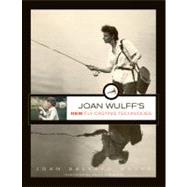
What is included with this book?
The New copy of this book will include any supplemental materials advertised. Please check the title of the book to determine if it should include any access cards, study guides, lab manuals, CDs, etc.
The Used, Rental and eBook copies of this book are not guaranteed to include any supplemental materials. Typically, only the book itself is included. This is true even if the title states it includes any access cards, study guides, lab manuals, CDs, etc.
Chapter One: To Cast a Fly
In boring literal terms, fly casting is the back and forth motion of the hand and arm with a fly rod and fly line, with the goal of creating open-ended unrolling loops to carry an artificial fly to a target area.
To those of us who love the sport of fly fishing, it is so much more! It is afeelingof an inanimate toolcoming to lifein your hand! This feeling may be only in your hand and arm when making short casts, but will start in the tips of your toes and move through your whole body when making long ones. Something about it reaches deep inside you; it is physically satisfying. Unrolling loops are a thing of beauty and can be mesmerizing, and the satisfaction of presenting a fly perfectly to a rising trout or a moving bonefish has no equal in this sport.
UNDERSTANDING THE DIFFERENCE!
The basic difference between fly casting and all other casting lies in the relative weight of the lure and the line. You can throw a bait-casting or spinning lure by hand, almost as far as you can cast it because it is acontainedweight like arock,with a “string” of weightless monofilament behind it.
As afly fisher, yourlureswill be essentially weightless: the imitations of insects and underwater creatures are made with materials like fur, feathers, tinsel, and yarn. Have you ever tried to throw a feather by hand? It is impossible. It has no weight and lots of air resistance. In fly casting, the weight you’ll cast is in thefly line.(Youcan literally cast a fly line by hand - no rod!) The fly, then, goes along as a passenger, at the end of a monofilamentleader. This ”leader” is the nearly invisible,taperingconnection between the thick fly line and the fly.
Because the fly line is long and flexible, its weight cannot flex the rod with just the short, snapping wrist-motion used in bait casting or spinning. The fly-casting stroke must havelength. It is astraight-linemovement by the rod hand, in anacceleration to a STOP!
The speed of the acceleration, plus the weight of the fly line,flexes/bendsthe rod, from the tipdownward. This is called “loading”the rod. When the acceleration is ended and the butt section of the rod isstopped, the bent rodunloads,with a spring-like action. The relatively limber rod tip flips over, taking with it the inches of line closest to it. As the tip oscillates back to straight, those inches of line form the beginning of what becomes anopen-endedunrollingloopwith upper and lower levels of line.
The formation of a loop is primary to each casting stroke. It must be done both backward (the backcast) and forward (the forward cast) for a complete cast, with the loops unrolling directly opposite each other.
TWO STROKES
There is no other sport that uses two strokes. Other sports, which are mostly ball sports, have you set up slowly on the back-swing and then whack the heck out of the ball to drive it forward. Not so in fly casting: the speed and power must beequalbackward and forward, for a given length of line. If you don’t use force on the backcast and then whack the heck out of the forward cast, your leader and fly will crack like a whip and you may lose the fly in the process. Because nothing in our lives gives us practice in throwing backward, it becomes the first challenge in learning to fly cast!
BASICTACKLE
Theflylineis the focal point of your tackle. You will choose theweightanddesign(the distribution of the weight) to suit the fishing you plan to do, and then choose a rod designated to cast that weight. This combination of rod and line is referred to as “an X-weightoutfit”. TheTACKLEchapter will give you expanded information on choices for various species. However, the ideal outfit to use for this casting instruction is a #6: a #6 weight fly rod with a #6 weight-forward floating fly line. This is anall-purposetroutfishingoutfit…as well as an all-purpose learning outfit. It is heavy enough to give you a range of casting distances from short to long but light enough, overall, to keep you from tiring too quickly in practice UNLESS you are a woman.
Women have approximately 55% of the upper body strength of men, pound for pound. Scary! It means that the weight of the tackle we use, though it is measured inounces,can be critical. In my generation, the weight of bamboo and glass rods (4-1/2oz.) was the primary factor in keeping women out of fly fishing. Even today, with the comparative lightness of modern materials (graphite and boron) we still have choices to make. Choose rods that are at the lighter end of the suggested weights in each line category, until experience tells you why you want something heavier.
ANDchoose a rod with a relatively small-diameter grip. (SeeArea of Focus: the Grip) Grips with uncomfortably large diameters were a second factor in keeping women from fly fishing.